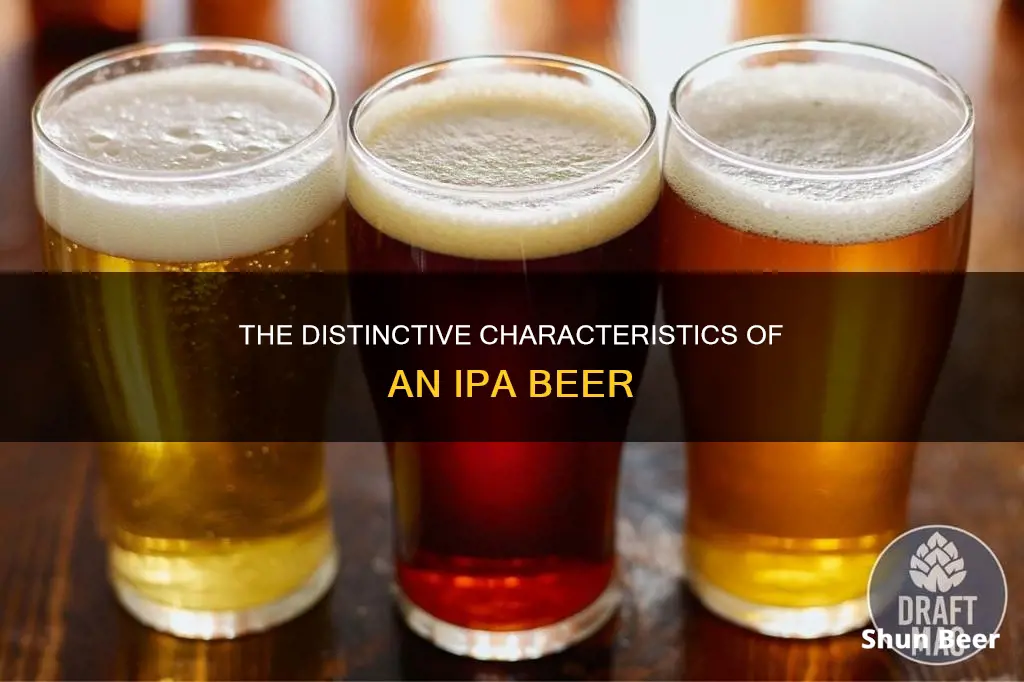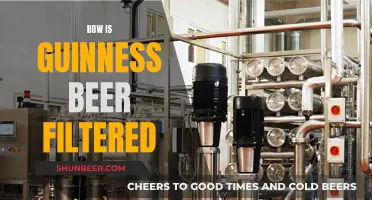
India Pale Ale (IPA) is a hoppy style of beer within the broader category of pale ales. IPAs were first brewed in England in the 19th century and were exported to India, which was under the control of the British East India Company until 1858. The term India Pale Ale was first used in an advertisement printed in Australia's first newspaper in 1829. IPAs are known for their high alcohol content and use of hops, which give them their distinctive bitter, earthy, piney, citrusy, and fruity flavours. The bitterness of an IPA can be measured using the International Bittering Units (IBU) scale, with the average IPA measuring between 40 and 60 IBUs.
Characteristics of an IPA
| Characteristics | Values |
|---|---|
| Full form | India Pale Ale |
| Origin | England, 19th century |
| Styles | American-style, English-style, Double or Imperial, New England, East Coast, West Coast, Black, Brut, Triple, White, Milkshake, Belgian, Sour, Brett, Hazy, Juicy, etc. |
| Alcohol content | Between 4.5% and 17.2% |
| Bitterness | Between 25 and 120 IBU |
| Flavours | Bitter, earthy, piney, citrusy, and fruity |
| Colour | Between 6 to 14 SRM |
| Original gravity | Between 1.05 and 1.09 |
What You'll Learn
- Alcohol content: IPAs have a higher alcohol content than other beers, ranging from 4.5% to 17.2% ABV
- Hoppiness: IPAs are known for their high levels of hops, which contribute to bitterness and flavours like citrus and pine
- Bitterness: The bitterness of an IPA is measured in International Bittering Units (IBU), with higher IBU indicating a more bitter beer
- Style: There are several styles of IPAs, including American, English, West Coast, and New England
- History: IPAs were originally brewed in England and exported to India during the British colonial era

Alcohol content: IPAs have a higher alcohol content than other beers, ranging from 4.5% to 17.2% ABV
The alcohol content of IPAs varies, but they generally have a higher alcohol content than other beers, with ABVs ranging from 4.5% to 17.2%.
IPAs were originally brewed with a higher alcohol content to help preserve the beer during its long journey from England to India. Early IPAs were only slightly higher in alcohol content than other beers of the time, but more of the wort was fermented, meaning there were fewer residual sugars.
Modern session IPAs usually fall below 5% ABV, while double or imperial IPAs have a higher ABV, typically over 7%. Double IPAs are stronger, with a higher alcohol content due to the increased amount of malt used. The extra malt provides more sugar for the yeast to convert into alcohol, resulting in a stronger brew. The average IPA stays at or below 7% ABV, while a double IPA will typically have an ABV between 7% and 10%.
The alcohol content of IPAs can vary depending on the style and the brewer. American IPAs usually have an ABV between 5.5% and 7.5%, while English-style IPAs range from 5% to 7% ABV. Belgian IPAs tend to have a higher ABV, ranging from 6.5% to 9%. New England IPAs, also known as hazy IPAs, typically have an ABV between 6.5% and 9%.
Guinness Beer: The Sparkling Truth About Carbonation
You may want to see also

Hoppiness: IPAs are known for their high levels of hops, which contribute to bitterness and flavours like citrus and pine
IPAs, or India Pale Ales, are known for their high levels of hops, which contribute to their bitterness and flavours like citrus and pine. Hops are flowers used as a flavouring and preservative in beer, and they give IPAs their distinct, bold taste.
There are many different types of hops that can be used in IPAs, each with its own unique flavour profile and characteristics. The types of hops most commonly used in IPA beers originated in the USA. One of the most popular types is Cascade, which is known for its strong citrus and pine aroma. It is often used in American-style IPAs and can be found in popular beers such as Sierra Nevada Pale Ale and Bell's Two Hearted Ale.
Another popular variety is Simcoe, which has a strong pine and earthy aroma. Beers such as Dogfish Head 60 Minute IPA and Stone IPA use Simcoe hops. Mosaic hops are also popular in IPAs; this variety is known for its tropical fruit and berry aroma and is used in beers like Ballast Point Sculpin IPA and Founders All Day IPA. Citra hops are also used in IPAs like Founders Centennial IPA and Sierra Nevada Torpedo Extra IPA. These hops are known for their strong citrus and tropical fruit flavours.
English-style IPAs typically use different hop varieties, such as East Kent Goldings and Fuggle, which have more earthy and floral aromas. The type of hops used in an IPA also plays a role in determining the beer's bitterness. Hops that are added early in the brewing process will make the beer bitterer, while those added later contribute more to the aroma.
The West Coast IPA is aggressively hoppy and bitter, with notes of citrus and pine. The New England IPA is defined by huge fruity hop flavours and is hazy and unfiltered. The East Coast IPA has strong hops but also a strong, slightly sweet malt character that balances the beer out.
Enjoying IPAs: A Beginner's Guide to Hoppy Beers
You may want to see also

Bitterness: The bitterness of an IPA is measured in International Bittering Units (IBU), with higher IBU indicating a more bitter beer
The bitterness of an IPA is a key characteristic of this style of beer. The bitterness is caused by the hops used in the brewing process. The more hops, the more bitter the beer will be. However, the presence of malt can balance out the bitterness by adding sweetness.
The bitterness of an IPA is measured in International Bittering Units (IBU). IBUs quantify the parts per million of isohumulone, the chemical compound that results when alpha acids from the hops are heated during the boil. The higher the concentration of isohumulone, the more bitter the beer will theoretically taste.
The IBU scale ranges from 0 to 120, with most beers falling between 15 and 80 IBU. Beers with an IBU of less than 20 will display little to no hops presence. Those with an IBU of 20 to 45 will have a mild to pronounced hops presence. Heavily hopped beers with an IBU greater than 45 will taste quite bitter.
IPAs typically have an IBU of 40 to 70, with some double and triple IPAs pushing the rating above 70. The average IPA will be between 40 and 60 IBUs.
While a higher IBU generally indicates a more bitter beer, it's important to note that other factors, such as malt and other flavourings, can mask the taste of bitterness. Therefore, a beer with a lower IBU and minimal malt may taste more bitter than a beer with a higher IBU and a strong malt profile.
IBUs are a useful tool for brewers to maintain consistency in the bitterness of their beers. However, they are not always a reliable indicator of how a beer will taste, as individual taste preferences and other ingredients can affect the perception of bitterness.
Porter or IPA: What's the Founder's Beer Style?
You may want to see also

Style: There are several styles of IPAs, including American, English, West Coast, and New England
There are several styles of IPAs, including American, English, West Coast, and New England varieties.
The original style of IPA is the English IPA, also known as a British IPA. These beers are hoppy golden ales that use exclusively British hops like Fuggles and Goldings, which give them an earthy and light citrus character. They are usually around 6-7% ABV and very dry. English IPAs are less common in the United States due to the use of British-only yeast and hops.
American IPAs, also known as American-style IPAs, are brewed with characteristically American hops, such as Cascade, Centennial, Citra, Columbus, Chinook, Simcoe, Amarillo, Tomahawk, Warrior, and Nugget. They are known for their intense hop aromas and fruity flavours.
West Coast IPAs were invented in California and take inspiration from British IPAs and American hops. They have a huge citrus aroma, verging on pine and slightly dank, weed-like smells. They are less dry than British IPAs because they often use crystal malt, but they are significantly more bitter.
New England IPAs, also known as hazy IPAs, are unfiltered and have extremely low bitterness due to the use of blends of hops that lend intense, fruity flavours. They are often dry-hopped and tend to be fermented to have lower carbonation. They typically have an ABV between 6% and 7.5%.
Converting Commercial Beer to IPA: The Ultimate Guide
You may want to see also

History: IPAs were originally brewed in England and exported to India during the British colonial era
The India Pale Ale, or IPA, is a style of beer with a distinct hoppy flavour and a rich history that dates back to the 18th century. IPAs were originally brewed in England and became popular among British colonists in India during the colonial era.
The origin story of the IPA begins in 1760 with the expansion of the British East India Company's trade into India. Beer was a popular drink among the company's employees and troops stationed in India, but the hot and humid climate presented a challenge for brewing and storing beer. The high temperatures accelerated the spoilage of beer, and the long journey from England to India often resulted in sour, stale, or contaminated beer.
To address this problem, British brewers created a new style of beer that could better withstand the long voyage and the hot Indian climate. They started brewing beers with higher alcohol content, as higher alcohol levels could act as a preservative, inhibiting microbial growth and extending the beer's shelf life. Additionally, brewers increased the amount of hops used in the brewing process. Hops not only added a bitter flavour but also had natural antimicrobial properties, which further helped to preserve the beer.
The earliest IPAs were brewed in Burton-upon-Trent, a town in the East Midlands of England. The brewers in Burton benefited from unique geological conditions that provided them with hard water containing high levels of sulphates, which contributed to a crisp, dry beer with a prominent hoppy character. These beers, known as October beers or "keeping beers," were brewed in the fall and allowed to mature and develop over the winter, ready for shipment to India in the spring. The long sea journey lasting several months acted as a form of "bottle conditioning," resulting in a clear, stable, and mature beer upon arrival in India.
Guinness Beer: Healthy or Harmful?
You may want to see also
Frequently asked questions
IPA stands for India Pale Ale. The drink was first brewed in England in the 19th century and exported to India, which was under the control of the British East India Company.
There are three main styles of IPAs: American-style IPA, English-style IPA, and Double or Imperial IPA.
IPAs are known for their high alcohol content and use of hops, which give them a bitter, earthy, piney, citrusy, and fruity flavour.







